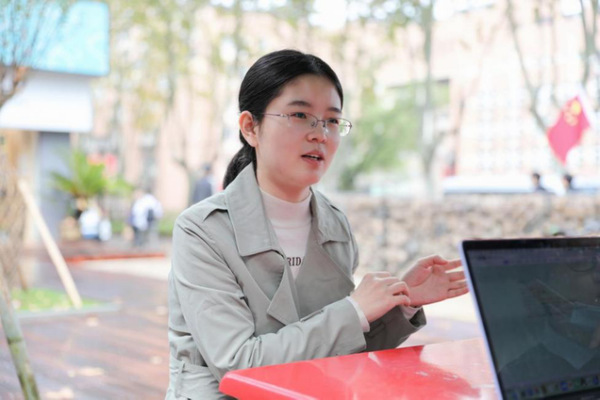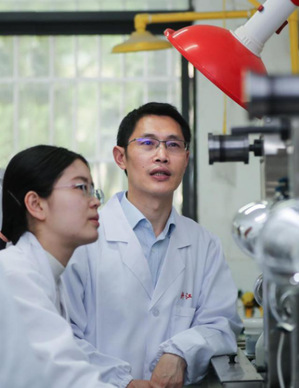Dialogue@ZJU: With CHANG Dan, recipient of the Chu Kochen Scholarship
[Editor’s Note: CHANG Dan, a doctoral student from Department of Polymer Science and Engineering, is one of the recipients of Chu Kochen Scholarship of Zhejiang University 2020-2021. Studious, innovative and patient, Chang had her research published in the journal Science as the first author and holds an international PCT patent. In this dialogue, we will learn more about her research, her take on women in science as well as her future plans.]

Q1: Could you tell me in a nutshell what your research is all about?
CHANG: My research is to discover an interesting phenomenon of reversible assembly and disassembly of artificial materials for the first time, namely the precisely reversible fusion and fission of graphene oxide (GO)-based fibers. The precise reversibility means the number, size, chemical composition, structure and property of GO fibers are recovered to the original state after a fusion and fission cycle. Under the stimulus of water or polar organic solvents, multiple macroscopic fibers fuse into a thicker fiber, and the fused one splits into numerous fibers that are identical to the initial single fibers. During the fusion and fission processes, the fibers occur self-adaptive deformation through swelling and shrinking, which ensures the precise reversibility.
Q2: What do you think your research mean to our society as a whole? And where do you see your research going in the future?
CHANG: Developing the material property of reversible assembly is favorable to exploiting smart functional applications in diverse fields, such as construction, clothing, biomedicine, and chemical catalysis, etc. Through the conformational adjustment strategy of GO two-dimensional macromolecules, we have successfully achieved precisely reversible fusion and fission of macroscopic GO-based fibers for the first time in the world. Taking the GO two-dimensional macromolecule as a model, the essential difference between two-dimensional macromolecules and other atoms and molecules is clarified, and a universal strategy for constructing the dynamic assembly interface is proposed. This research enriches the theoretical science of two-dimensional macromolecules, and facilitates the technological advance to produce high-performance carbon-based fibers and intelligent stimuli-responsive materials in our society. Additionally, this study promotes the recycling of artificial materials.
In the future, the mechanism of reversible assembly should be studied more deeply to understand and regulate this property. Based on the reversible assembly ability, many functional applications could be further developed, including fabrication of structural materials with high mechanical performance, smart dynamic assembly, controlled delivery in biomedicine, recyclable environment-friendly materials, etc. More possibilities in other application areas are expected to be explored. We hope this research direction will propel the materials toward intelligence and environmental protection, facilitating the progress of material technology and green sustainable development in our society.

CHANG Dan conducted the experiment under the guidance of Prof. GAO Chao in the lab
Q3: Getting your paper published in first-tier journals like Science must be an arduous journey. Have you encountered any difficulties in the process? What kind of help did you get from your mentors and your department?
CHANG: Yes, there have been many difficulties in the study procedure. For example, the experimental difficulties regarding the characterization of fusion and fission processes, as well as the verification of chemical component of GO fibers. In addition, how to design and complete supplementary experiments for responding to review comments in a quick and effective manner is also a challenge. Furthermore, the long research duration results in mental pressure. Positive and patient attitudes are necessary to ensure the achievement of research topic.
I am very grateful to the teachers and colleagues of our research group—Nano-polymer Research Group of the Department of Polymer Science and Engineering of Zhejiang University, especially my supervisor, Prof. GAO Chao, for their help in the study process. Prof. Gao directed my research topic and paper writing, as well as encouraged and supported me to overcome many difficulties. Moreover, the discussion with Dr. LI Zheng also gave me a lot of inspirations. In addition, I would also like to thank our department for the instrumental support and academic exchange during the investigation.
Q4: As a female researcher, what do you think are the advantages and drawbacks of women in science? And do you have any message for girls who aspire to pursue an academic career?
CHANG: To some extent, the female researchers do differ from male. Generally, I think women working on scientific research can easily exert the good communication skills and meticulous experiment techniques. However, it is possible that female researchers devote more energy to the family, and need to strike a better balance between scientific research and family.
In order to become a scientist, girls may make an effort from three aspects. Firstly, finding the research direction and enjoying the scientific research. Secondly, it will be useful to improve work efficiency and stay focused. Thirdly, it is better to plan the future career and strive to gain knowledge and make creation during the study procedure. These points also act as the criteria that I aim to achieve.
Q5: Upon graduation, do you have any plans for the future?
CHANG: In the future, I plan to work in a university and continue to study the physicochemical properties and functional applications of artificial materials. I will focus on overcoming the existing problems in the present research topic, and promoting the development of the research direction of reversible assembly. Dynamic assemblies that can be strengthened, split, reassembled, and applicatory are pursued. Moreover, I would like to learn the studies in other research fields to expand my academic horizon. The new knowledge will be applied in my investigation, thereby solving important technical problems in the future study.
Interviewer: ZHANG Yuting (’23, Translation and Interpretation)
Editor: SHI Yuxi (’23, French), TIAN Minjie
Photo credit: LU Shaoqing, Wu Wu